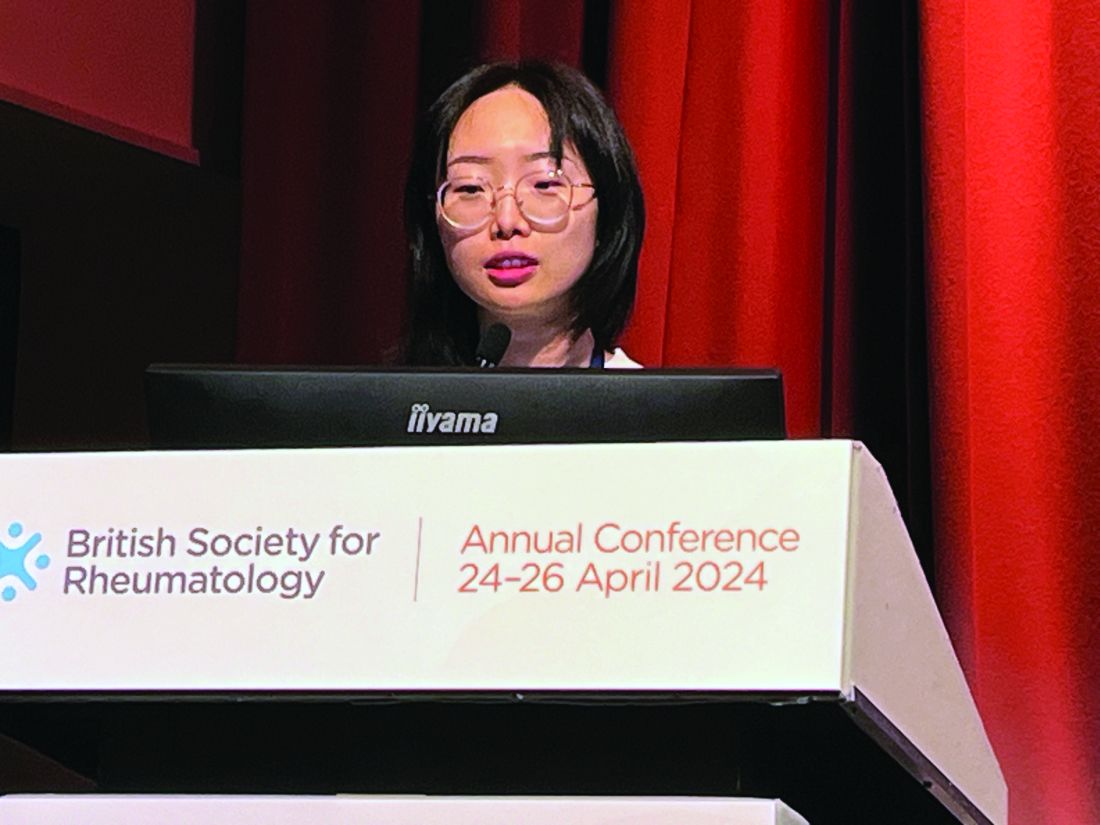User login
LIVERPOOL, ENGLAND — Four in five people with rheumatoid arthritis (RA) fall into “at risk” categories for the initiation of Janus kinase (JAK) inhibitors set by the European Medicines Agency (EMA), according to data from the long-running British Society for Rheumatology (BSR) Biologics Register in RA (BSRBR-RA).
The EMA decided in January 2023 to implement measures to reduce the risk for serious side effects with JAK inhibitors in the treatment of chronic inflammatory diseases. The EMA’s recommendations advise that JAK inhibitors “should be used in the following patients only if no suitable treatment alternatives are available: those aged 65 years or above, those at increased risk of major cardiovascular problems (such as heart attack or stroke), those who smoke or have done so for a long time in the past, and those at increased risk of cancer.” The guidance also says to use JAK inhibitors “with caution in patients with risk factors for blood clots in the lungs and in deep veins (venous thromboembolism [VTE]) ... [and that] the doses should be reduced in patient groups who are at risk of VTE, cancer, or major cardiovascular problems, where possible.”
To gauge the potential impact of the EMA’s decision, researchers analyzed BSRBR-RA data from 1341 individuals with RA who had started treatment with a JAK inhibitor before the agency issued its new recommendations. Among these individuals, 1075 (80.2%) met ≥ 1 EMA risk criterion. Half (54%) were current or past smokers, 44% had an increased risk for major cardiovascular events such as heart attack or stroke, 39% were 65 years or older, and 10% had an increased risk for cancer.
Nearly half (49%) of the study population who met ≥ 1 EMA risk criterion had received only one (31%) or no (18%) prior biologic disease-modifying antirheumatic drug (bDMARD), Zixing Tian, a PhD student at the University of Manchester in England, reported at the annual meeting of the British Society for Rheumatology. Of the remainder, 23% had received two prior bDMARDs, and 28% had previously received three or more bDMARDs.
The work suggests that majority of people who are currently being treated with JAK inhibitors would probably not be advised to start treatment with a JAK inhibitor today, the researchers suggested in their abstract.
Considerable Implications
There are potentially two ways of interpreting these data, suggested Ken Baker, BMBCh, PhD, senior clinical fellow and honorary consultant rheumatologist at Newcastle University in Newcastle upon Tyne, England.
“One is that rheumatologists starting these treatments are throwing caution to the wind and ignoring all guidance,” Dr. Baker said.
“The second is perhaps that the EMA guidance is difficult to implement in practice when it involves lots of the comorbidities and risk factors that commonly affect patients with rheumatoid arthritis.”
Paul Emery, MD, Versus Arthritis professor of rheumatology and director of the Leeds Biomedical Research Centre at the University of Leeds in England, also commented on the findings.
“We are going to exclude practically all of our patients if we follow EMA,” Dr. Emery said. “The implications are considerable because if someone has a DVT [deep vein thrombosis] or an MI [myocardial infarction], when we included them with a risk factor, what’s the implication if they choose to sue you?”
Moreover, the bigger question is what to do with all the people who are already established on a JAK inhibitor, Dr. Emery said. Should patients now switch off their medication? Doing so may well leave them with a period of inflammation that may be more harmful than continuing the JAK inhibitor, he suggested.
Were Cautions Warranted?
Like the US Food and Drug Administration, the EMA has concerns over the use of JAK inhibitors because of the drugs’ potential to increase the risk for serious side effects such as VTE, major adverse cardiovascular events, cancer, and all-cause mortality relative to tumor necrosis factor–alpha inhibitors.
Initially, the EMA issued cautions that only related to the use of tofacitinib (Xeljanz), which was the first JAK inhibitor to gain approval for RA and other chronic inflammatory diseases in Europe, but this expanded to include baricitinib (Olumiant) and most recently any member of the drug class, including abrocitinib (Cibinqo), filgotinib (Jyseleca), and upadacitinib (Rinvoq).
The EMA has done a responsible job of looking at the available data and issuing cautions to protect the populations of patients who may be exposed to these drugs, Peter C. Taylor, BMBCh, PhD, told this news organization. However, they are also severely restricting the populations of patients who can be treated with them. “It’s a complicated situation,” he said.
Dr. Taylor, the Norman Collisson chair of musculoskeletal medicine at the University of Oxford in England, was not only involved in some of the major JAK inhibitor clinical trials but also privy to the EMA’s recent deliberations as an observer during the process. He noted that the EMA originally considered restricting the use of the drug class in patients older than 50 years but settled upon age 65 years and older.
Shared Decision
“The issue for benefit and risk is there for any drug we use,” said Dr. Taylor, noting that there are over-the-counter drugs that can be “far more dangerous” than JAK inhibitors in terms of cardiovascular risk.
“In my opinion, the really key thing is to be able to communicate the issues with integrity, in a manner that the patient understands, to make sure that the risk is acceptable to them,” Dr. Taylor said.
It is all about optimizing treatment for an individual and proactively managing any other factors that may increase their personal risk for unwanted effects, Maya Buch, MBChB, PhD, professor of rheumatology and honorary consultant rheumatologist at the University of Manchester, said during a debate at the meeting.
“We still have unmet needs for our patient population. Patients aren’t achieving the goals and endpoints that we need,” Dr. Buch said.
“Don’t lose sight of the positive attributes that we’ve seen with JAK inhibitors,” she advised.
“We presume we know what the patient thinks when it comes to a matter of risk assessment, but it is always about tailoring treatment to that individual, and we are sometimes surprised in terms of what the patients want, even in the face of apparent higher risk,” Dr. Buch added.
Judicious Use
Iain McInnes, MBChB, PhD, observed during the same debate that it was “hard to argue that drugs are generally unsafe when they have already been approved. It’s also challenging to suggest they are not useful when they are being used.”
Dr. McInnes, honorary consultant rheumatologist and vice principal and head of the College of Medical Veterinary & Life Sciences at the University of Glasgow in Scotland, pointed out that the EMA warnings assume that all JAK inhibitors are the same, but is that really the case? This is complex biochemistry, and could newer JAK inhibitors have an improved safety profile?
“There is no free ride in the immune system, and we should bear that in mind,” Dr. McInnes said. “These drugs work ... but we are absolutely flitting along the boundaries of the safety/efficacy window.”
Dr. McInnes told this news organization that clinicians do have to be cautious.
“There’s a paradox in that the very age group that the regulators are now asking us to be cautious about prescribing is pushing JAK inhibitors later and later in the disease course,” he said. This is a time when people would already have other risks for cardiovascular and other events.
“Overall, if used within the regulatory advice, Janus kinase inhibitors are a really useful drug class.”
The BSRBR-RA is funded by a grant from the BSR. The BSR currently receives funding from AbbVie, Amgen, Celltrion, Eli Lilly, Pfizer, Samsung Bioepis, Sanofi, and Sandoz and in the past from Hospira, Merck Sharp & Dohme (MSD), Roche, SOBI, and UCB. This income finances a wholly separate contract between the BSR and the University of Manchester to host the BSRBR-RA. All decisions concerning study design, data capture, analyses, interpretation, and publication are made autonomously of any industrial contribution. Ms. Tian had no conflicts of interest to report. Dr. Emery disclosed ties to AbbVie, Bristol Myers Squibb (BMS), Eli Lilly, Pfizer, MSD, Novartis, Roche, Sandoz, Samsung, and UCB. Dr. Taylor disclosed ties to AbbVie, Biogen, Eli Lilly, Fresenius, Galapagos, Gilead Sciences, GlaxoSmithKline, Janssen, Nordic Pharma, Pfizer, Sanofi, Aqtual, and UCB. Dr. Buch disclosed ties to Gilead, AbbVie, Arxx Therapeutics, Boehringer Ingelheim, CESAS Medical, Galapagos, Gilead, MediStreams, and Pfizer. Dr. McInnes disclosed ties to AbbVie, AstraZeneca, Boehringer Ingelheim, Compugen, Cabaletta Bio, Causeway, Dexterra, Eli Lilly, Celgene, MoonLake, Pfizer, Novartis, Janssen, Roche, and UCB.
A version of this article appeared on Medscape.com .
LIVERPOOL, ENGLAND — Four in five people with rheumatoid arthritis (RA) fall into “at risk” categories for the initiation of Janus kinase (JAK) inhibitors set by the European Medicines Agency (EMA), according to data from the long-running British Society for Rheumatology (BSR) Biologics Register in RA (BSRBR-RA).
The EMA decided in January 2023 to implement measures to reduce the risk for serious side effects with JAK inhibitors in the treatment of chronic inflammatory diseases. The EMA’s recommendations advise that JAK inhibitors “should be used in the following patients only if no suitable treatment alternatives are available: those aged 65 years or above, those at increased risk of major cardiovascular problems (such as heart attack or stroke), those who smoke or have done so for a long time in the past, and those at increased risk of cancer.” The guidance also says to use JAK inhibitors “with caution in patients with risk factors for blood clots in the lungs and in deep veins (venous thromboembolism [VTE]) ... [and that] the doses should be reduced in patient groups who are at risk of VTE, cancer, or major cardiovascular problems, where possible.”
To gauge the potential impact of the EMA’s decision, researchers analyzed BSRBR-RA data from 1341 individuals with RA who had started treatment with a JAK inhibitor before the agency issued its new recommendations. Among these individuals, 1075 (80.2%) met ≥ 1 EMA risk criterion. Half (54%) were current or past smokers, 44% had an increased risk for major cardiovascular events such as heart attack or stroke, 39% were 65 years or older, and 10% had an increased risk for cancer.
Nearly half (49%) of the study population who met ≥ 1 EMA risk criterion had received only one (31%) or no (18%) prior biologic disease-modifying antirheumatic drug (bDMARD), Zixing Tian, a PhD student at the University of Manchester in England, reported at the annual meeting of the British Society for Rheumatology. Of the remainder, 23% had received two prior bDMARDs, and 28% had previously received three or more bDMARDs.
The work suggests that majority of people who are currently being treated with JAK inhibitors would probably not be advised to start treatment with a JAK inhibitor today, the researchers suggested in their abstract.
Considerable Implications
There are potentially two ways of interpreting these data, suggested Ken Baker, BMBCh, PhD, senior clinical fellow and honorary consultant rheumatologist at Newcastle University in Newcastle upon Tyne, England.
“One is that rheumatologists starting these treatments are throwing caution to the wind and ignoring all guidance,” Dr. Baker said.
“The second is perhaps that the EMA guidance is difficult to implement in practice when it involves lots of the comorbidities and risk factors that commonly affect patients with rheumatoid arthritis.”
Paul Emery, MD, Versus Arthritis professor of rheumatology and director of the Leeds Biomedical Research Centre at the University of Leeds in England, also commented on the findings.
“We are going to exclude practically all of our patients if we follow EMA,” Dr. Emery said. “The implications are considerable because if someone has a DVT [deep vein thrombosis] or an MI [myocardial infarction], when we included them with a risk factor, what’s the implication if they choose to sue you?”
Moreover, the bigger question is what to do with all the people who are already established on a JAK inhibitor, Dr. Emery said. Should patients now switch off their medication? Doing so may well leave them with a period of inflammation that may be more harmful than continuing the JAK inhibitor, he suggested.
Were Cautions Warranted?
Like the US Food and Drug Administration, the EMA has concerns over the use of JAK inhibitors because of the drugs’ potential to increase the risk for serious side effects such as VTE, major adverse cardiovascular events, cancer, and all-cause mortality relative to tumor necrosis factor–alpha inhibitors.
Initially, the EMA issued cautions that only related to the use of tofacitinib (Xeljanz), which was the first JAK inhibitor to gain approval for RA and other chronic inflammatory diseases in Europe, but this expanded to include baricitinib (Olumiant) and most recently any member of the drug class, including abrocitinib (Cibinqo), filgotinib (Jyseleca), and upadacitinib (Rinvoq).
The EMA has done a responsible job of looking at the available data and issuing cautions to protect the populations of patients who may be exposed to these drugs, Peter C. Taylor, BMBCh, PhD, told this news organization. However, they are also severely restricting the populations of patients who can be treated with them. “It’s a complicated situation,” he said.
Dr. Taylor, the Norman Collisson chair of musculoskeletal medicine at the University of Oxford in England, was not only involved in some of the major JAK inhibitor clinical trials but also privy to the EMA’s recent deliberations as an observer during the process. He noted that the EMA originally considered restricting the use of the drug class in patients older than 50 years but settled upon age 65 years and older.
Shared Decision
“The issue for benefit and risk is there for any drug we use,” said Dr. Taylor, noting that there are over-the-counter drugs that can be “far more dangerous” than JAK inhibitors in terms of cardiovascular risk.
“In my opinion, the really key thing is to be able to communicate the issues with integrity, in a manner that the patient understands, to make sure that the risk is acceptable to them,” Dr. Taylor said.
It is all about optimizing treatment for an individual and proactively managing any other factors that may increase their personal risk for unwanted effects, Maya Buch, MBChB, PhD, professor of rheumatology and honorary consultant rheumatologist at the University of Manchester, said during a debate at the meeting.
“We still have unmet needs for our patient population. Patients aren’t achieving the goals and endpoints that we need,” Dr. Buch said.
“Don’t lose sight of the positive attributes that we’ve seen with JAK inhibitors,” she advised.
“We presume we know what the patient thinks when it comes to a matter of risk assessment, but it is always about tailoring treatment to that individual, and we are sometimes surprised in terms of what the patients want, even in the face of apparent higher risk,” Dr. Buch added.
Judicious Use
Iain McInnes, MBChB, PhD, observed during the same debate that it was “hard to argue that drugs are generally unsafe when they have already been approved. It’s also challenging to suggest they are not useful when they are being used.”
Dr. McInnes, honorary consultant rheumatologist and vice principal and head of the College of Medical Veterinary & Life Sciences at the University of Glasgow in Scotland, pointed out that the EMA warnings assume that all JAK inhibitors are the same, but is that really the case? This is complex biochemistry, and could newer JAK inhibitors have an improved safety profile?
“There is no free ride in the immune system, and we should bear that in mind,” Dr. McInnes said. “These drugs work ... but we are absolutely flitting along the boundaries of the safety/efficacy window.”
Dr. McInnes told this news organization that clinicians do have to be cautious.
“There’s a paradox in that the very age group that the regulators are now asking us to be cautious about prescribing is pushing JAK inhibitors later and later in the disease course,” he said. This is a time when people would already have other risks for cardiovascular and other events.
“Overall, if used within the regulatory advice, Janus kinase inhibitors are a really useful drug class.”
The BSRBR-RA is funded by a grant from the BSR. The BSR currently receives funding from AbbVie, Amgen, Celltrion, Eli Lilly, Pfizer, Samsung Bioepis, Sanofi, and Sandoz and in the past from Hospira, Merck Sharp & Dohme (MSD), Roche, SOBI, and UCB. This income finances a wholly separate contract between the BSR and the University of Manchester to host the BSRBR-RA. All decisions concerning study design, data capture, analyses, interpretation, and publication are made autonomously of any industrial contribution. Ms. Tian had no conflicts of interest to report. Dr. Emery disclosed ties to AbbVie, Bristol Myers Squibb (BMS), Eli Lilly, Pfizer, MSD, Novartis, Roche, Sandoz, Samsung, and UCB. Dr. Taylor disclosed ties to AbbVie, Biogen, Eli Lilly, Fresenius, Galapagos, Gilead Sciences, GlaxoSmithKline, Janssen, Nordic Pharma, Pfizer, Sanofi, Aqtual, and UCB. Dr. Buch disclosed ties to Gilead, AbbVie, Arxx Therapeutics, Boehringer Ingelheim, CESAS Medical, Galapagos, Gilead, MediStreams, and Pfizer. Dr. McInnes disclosed ties to AbbVie, AstraZeneca, Boehringer Ingelheim, Compugen, Cabaletta Bio, Causeway, Dexterra, Eli Lilly, Celgene, MoonLake, Pfizer, Novartis, Janssen, Roche, and UCB.
A version of this article appeared on Medscape.com .
LIVERPOOL, ENGLAND — Four in five people with rheumatoid arthritis (RA) fall into “at risk” categories for the initiation of Janus kinase (JAK) inhibitors set by the European Medicines Agency (EMA), according to data from the long-running British Society for Rheumatology (BSR) Biologics Register in RA (BSRBR-RA).
The EMA decided in January 2023 to implement measures to reduce the risk for serious side effects with JAK inhibitors in the treatment of chronic inflammatory diseases. The EMA’s recommendations advise that JAK inhibitors “should be used in the following patients only if no suitable treatment alternatives are available: those aged 65 years or above, those at increased risk of major cardiovascular problems (such as heart attack or stroke), those who smoke or have done so for a long time in the past, and those at increased risk of cancer.” The guidance also says to use JAK inhibitors “with caution in patients with risk factors for blood clots in the lungs and in deep veins (venous thromboembolism [VTE]) ... [and that] the doses should be reduced in patient groups who are at risk of VTE, cancer, or major cardiovascular problems, where possible.”
To gauge the potential impact of the EMA’s decision, researchers analyzed BSRBR-RA data from 1341 individuals with RA who had started treatment with a JAK inhibitor before the agency issued its new recommendations. Among these individuals, 1075 (80.2%) met ≥ 1 EMA risk criterion. Half (54%) were current or past smokers, 44% had an increased risk for major cardiovascular events such as heart attack or stroke, 39% were 65 years or older, and 10% had an increased risk for cancer.
Nearly half (49%) of the study population who met ≥ 1 EMA risk criterion had received only one (31%) or no (18%) prior biologic disease-modifying antirheumatic drug (bDMARD), Zixing Tian, a PhD student at the University of Manchester in England, reported at the annual meeting of the British Society for Rheumatology. Of the remainder, 23% had received two prior bDMARDs, and 28% had previously received three or more bDMARDs.
The work suggests that majority of people who are currently being treated with JAK inhibitors would probably not be advised to start treatment with a JAK inhibitor today, the researchers suggested in their abstract.
Considerable Implications
There are potentially two ways of interpreting these data, suggested Ken Baker, BMBCh, PhD, senior clinical fellow and honorary consultant rheumatologist at Newcastle University in Newcastle upon Tyne, England.
“One is that rheumatologists starting these treatments are throwing caution to the wind and ignoring all guidance,” Dr. Baker said.
“The second is perhaps that the EMA guidance is difficult to implement in practice when it involves lots of the comorbidities and risk factors that commonly affect patients with rheumatoid arthritis.”
Paul Emery, MD, Versus Arthritis professor of rheumatology and director of the Leeds Biomedical Research Centre at the University of Leeds in England, also commented on the findings.
“We are going to exclude practically all of our patients if we follow EMA,” Dr. Emery said. “The implications are considerable because if someone has a DVT [deep vein thrombosis] or an MI [myocardial infarction], when we included them with a risk factor, what’s the implication if they choose to sue you?”
Moreover, the bigger question is what to do with all the people who are already established on a JAK inhibitor, Dr. Emery said. Should patients now switch off their medication? Doing so may well leave them with a period of inflammation that may be more harmful than continuing the JAK inhibitor, he suggested.
Were Cautions Warranted?
Like the US Food and Drug Administration, the EMA has concerns over the use of JAK inhibitors because of the drugs’ potential to increase the risk for serious side effects such as VTE, major adverse cardiovascular events, cancer, and all-cause mortality relative to tumor necrosis factor–alpha inhibitors.
Initially, the EMA issued cautions that only related to the use of tofacitinib (Xeljanz), which was the first JAK inhibitor to gain approval for RA and other chronic inflammatory diseases in Europe, but this expanded to include baricitinib (Olumiant) and most recently any member of the drug class, including abrocitinib (Cibinqo), filgotinib (Jyseleca), and upadacitinib (Rinvoq).
The EMA has done a responsible job of looking at the available data and issuing cautions to protect the populations of patients who may be exposed to these drugs, Peter C. Taylor, BMBCh, PhD, told this news organization. However, they are also severely restricting the populations of patients who can be treated with them. “It’s a complicated situation,” he said.
Dr. Taylor, the Norman Collisson chair of musculoskeletal medicine at the University of Oxford in England, was not only involved in some of the major JAK inhibitor clinical trials but also privy to the EMA’s recent deliberations as an observer during the process. He noted that the EMA originally considered restricting the use of the drug class in patients older than 50 years but settled upon age 65 years and older.
Shared Decision
“The issue for benefit and risk is there for any drug we use,” said Dr. Taylor, noting that there are over-the-counter drugs that can be “far more dangerous” than JAK inhibitors in terms of cardiovascular risk.
“In my opinion, the really key thing is to be able to communicate the issues with integrity, in a manner that the patient understands, to make sure that the risk is acceptable to them,” Dr. Taylor said.
It is all about optimizing treatment for an individual and proactively managing any other factors that may increase their personal risk for unwanted effects, Maya Buch, MBChB, PhD, professor of rheumatology and honorary consultant rheumatologist at the University of Manchester, said during a debate at the meeting.
“We still have unmet needs for our patient population. Patients aren’t achieving the goals and endpoints that we need,” Dr. Buch said.
“Don’t lose sight of the positive attributes that we’ve seen with JAK inhibitors,” she advised.
“We presume we know what the patient thinks when it comes to a matter of risk assessment, but it is always about tailoring treatment to that individual, and we are sometimes surprised in terms of what the patients want, even in the face of apparent higher risk,” Dr. Buch added.
Judicious Use
Iain McInnes, MBChB, PhD, observed during the same debate that it was “hard to argue that drugs are generally unsafe when they have already been approved. It’s also challenging to suggest they are not useful when they are being used.”
Dr. McInnes, honorary consultant rheumatologist and vice principal and head of the College of Medical Veterinary & Life Sciences at the University of Glasgow in Scotland, pointed out that the EMA warnings assume that all JAK inhibitors are the same, but is that really the case? This is complex biochemistry, and could newer JAK inhibitors have an improved safety profile?
“There is no free ride in the immune system, and we should bear that in mind,” Dr. McInnes said. “These drugs work ... but we are absolutely flitting along the boundaries of the safety/efficacy window.”
Dr. McInnes told this news organization that clinicians do have to be cautious.
“There’s a paradox in that the very age group that the regulators are now asking us to be cautious about prescribing is pushing JAK inhibitors later and later in the disease course,” he said. This is a time when people would already have other risks for cardiovascular and other events.
“Overall, if used within the regulatory advice, Janus kinase inhibitors are a really useful drug class.”
The BSRBR-RA is funded by a grant from the BSR. The BSR currently receives funding from AbbVie, Amgen, Celltrion, Eli Lilly, Pfizer, Samsung Bioepis, Sanofi, and Sandoz and in the past from Hospira, Merck Sharp & Dohme (MSD), Roche, SOBI, and UCB. This income finances a wholly separate contract between the BSR and the University of Manchester to host the BSRBR-RA. All decisions concerning study design, data capture, analyses, interpretation, and publication are made autonomously of any industrial contribution. Ms. Tian had no conflicts of interest to report. Dr. Emery disclosed ties to AbbVie, Bristol Myers Squibb (BMS), Eli Lilly, Pfizer, MSD, Novartis, Roche, Sandoz, Samsung, and UCB. Dr. Taylor disclosed ties to AbbVie, Biogen, Eli Lilly, Fresenius, Galapagos, Gilead Sciences, GlaxoSmithKline, Janssen, Nordic Pharma, Pfizer, Sanofi, Aqtual, and UCB. Dr. Buch disclosed ties to Gilead, AbbVie, Arxx Therapeutics, Boehringer Ingelheim, CESAS Medical, Galapagos, Gilead, MediStreams, and Pfizer. Dr. McInnes disclosed ties to AbbVie, AstraZeneca, Boehringer Ingelheim, Compugen, Cabaletta Bio, Causeway, Dexterra, Eli Lilly, Celgene, MoonLake, Pfizer, Novartis, Janssen, Roche, and UCB.
A version of this article appeared on Medscape.com .
FROM BSR 2024




